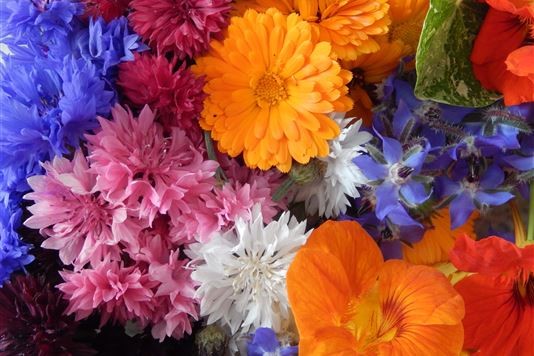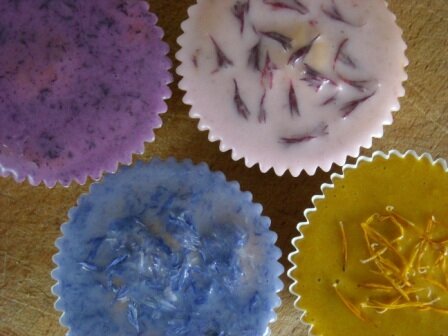How to cook with edible flowers

Inspired by Chelsea? Rachael Voaden, founder of The Edible Flower Shop, shows us how to make floral butters, crystallised petals and natural food colouring with edible flowers.
After having great success with edible flowers in her own rural Devonshire garden, Rachael Voaden decided to make a business of it. She currently sells 54 varieties of edible flowers via her website (including borage, daisies, cornflowers and chamomile), and each seed packet comes with growing guides and post-harvest recipe suggestions.
Edible flowers can suit any sized growing space, from window boxes to courtyard gardens, allotments and large country estates. “There is a misconception that edible flowers only suit Michelin-star type cooking," says Rachael. "[But actually] everyone with access to outside areas has the potential to grow and eat them.
"Flowers have been eaten for centuries, but fell out of favour in recent decades. So living in a society where growing space comes at a premium, isn’t it time we made the most of what we’ve got?”
Rachael, who includes 'perfect for pollinators' flowers approved by the RHS in her range, uses edible flowers as flavourings, decorations, and even in ice cubes. Here are some of her favourite edible flower experiments for you to try at home.
Floral butters

Floral butters are a quick and easy way to add colour and flavour to both sweet and savoury dishes. Some edible flowers (such as lavender, chive flowers, Mexican tarragon, nasturtiums, rose petals and giant hyssop) will give butter a distinct flavour. Others (including cornflowers, dianthus, violas, pansies and polyanthus) will add a milder flavour to the butter, but provide you with beautiful colour.
Method
Ensure the butter is at room temperature. Prepare the flowers by removing the petals and chopping them finely. Mix the chopped petals into the butter, along with any other ingredients you wish to include. Put the floral butter into a small ramekin, or roll in cling film to create a small sausage shape, which can be sliced later to give small discs of flavoured butter. Return butter to the fridge to set.
Sweet floral butters make lovely accompaniments to scones, cakes, French toast or biscuits. Try mixing a combination of flowers with other ingredients such as icing sugar, lemon juice, orange zest, cinnamon or honey. Or get a rainbow effect with a mix of cornflowers, bergamot and calendula petals.
Savoury floral butters are delicious served with a fresh, warm baguette, in a baked potato, with savoury biscuits, melted over lightly steamed vegetables, or with grilled fish. Try this chive flower butter recipe.
Crystallised flowers
 Crystallised edible flowers make stunning cake decorations and are lovely garnishes to desserts. Violas and pansies are a popular choice for crystallising, as are dianthus, Sweet Williams, polyanthus, primulas and rose petals.
Crystallised edible flowers make stunning cake decorations and are lovely garnishes to desserts. Violas and pansies are a popular choice for crystallising, as are dianthus, Sweet Williams, polyanthus, primulas and rose petals.
Method
You will need one egg white, caster sugar, a small, clean paint brush, edible flowers, and greaseproof paper. Ensure that the flowers are dry before commencing. You can work with individual petals that have been separated from the flower, or whole flowers. If you wish to use the whole flower please ensure that they are suitable for eating whole.
Using a small brush, paint the petals or flower all over with egg white. Sprinkle a light coating of sugar over all painted surfaces. Make sure you cover the whole petal/flower as any part you miss will quickly wilt and lose its colour. Dry overnight on greaseproof paper in a warm, dry place. Whole flowers will need to be turned to ensure the entire flower is dried.
For flowers that last a little longer, or for a vegan alternative to egg white, replace the egg white with gum arabic which can be purchased from chemists. Dissolve at a ratio of 1 teaspoon to 1½ tablespoons of water.
Natural food colouring

Never again do you need to buy food colouring or use artificially created colours. Growing and making your own natural food colouring is incredibly easy with edible flowers.
Try these easy to grow flowers for nearly every colour in the rainbow: Cornflower Black Ball (actually makes purple), Cornflower Blue Ball, Cornflower Red Ball, Calendula Bon Bon Orange, and Calendula Bon Bon Yellow. Cornflowers are particularly well suited to cake making as their mild flavour means you can add vibrant colour without changing the flavour of the cakes or icing. Calendula has a more distinct flavour and so is best used in savoury cooking or perhaps to add colour along with stronger flavours such as citrus.
Method
Pick your flowers on a dry day, as soon as they are fully open. Dry them by hanging upside down in loose bunches, or remove the petals and spread finely on a plate or tray. Leave in a warm, dry location. Inspect daily to check for spoiling and remove affected flowers.
As soon as the petals are fully dry (about a week later), they are ready to be ground. Do so with a pestle and mortar, or a clean coffee grinder. Using a pestle and mortar requires a little elbow grease but it does work eventually – I promise!
Keep working the petals until you have a fine dust. The finer the better. If you are happy to have a speckled effect from your colouring then don't worry if you have a few small unground petal fragments remaining.
Either use the powder immediately to add to icing, custards, or other foods. Or add to a clean, sealable jar and keep in a cupboard until you are ready to use it.
You can discover more of Rachael's edible flower experiments on The Edible Flower Shop blog.
This is a classic loveFOOD article
You might also like
Goats' cheese dip in tulip petals recipe
Comments
Be the first to comment
Do you want to comment on this article? You need to be signed in for this feature